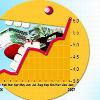Topics: Business Tags: Inflation View |
Topics: Business Tags: Inflation View |
Tags: Inflation View |
|||||||||
Tags: Inflation View |
inflation is a rise in the general level of prices (price level) of goods and services in an economy over a period of time. When the price level rises, each unit of currency buys fewer goods and services; consequently, annual inflation is also an erosion in the purchasing power of money - a loss of real value in the internal medium of exchange and unit of account in the economy. A chief measure of price inflation is the inflation rate, the annualized percentage change in a general price index (normally the Consumer Price Index) over time.
Inflations effects on an economy (#Effects) are manifold and can be simultaneously positive (#Positive) and negative (#Negative). Negative effects of inflation include a decrease in the real value of money and other monetary items over time; uncertainty about future inflation may discourage investment and saving, or may lead to reductions in investment of productive capital and increase savings in non-producing assets. e.g. selling stocks and buying gold. This can reduce overall economic productivity rates, as the capital required to retool companies becomes more elusive or expensive. High inflation may lead to shortages of goods (good (economics)) if consumers begin hoarding out of concern that prices will increase in the future. Positive effects include a mitigation of economic recessions, and debt relief by reducing the real level of debt.
High rates of inflation and hyperinflation can be caused by an excessive growth of the money supply. Views on which factors determine low to moderate rates of inflation are more varied. Low or moderate inflation may be attributed to fluctuations in real (real versus nominal value) demand for goods and services, or changes in available supplies such as during scarcities (scarcity), as well as to growth in the money supply. However, the consensus view is that a long sustained period of inflation is caused by money supply growing faster than the rate of economic growth.
Today, most mainstream economists favor a low steady rate of inflation. Low (as opposed to zero or negative (Deflation)) inflation may reduce the severity of economic recessions by enabling the labor market to adjust more quickly in a downturn, and reduce the risk that a liquidity trap prevents monetary policy from stabilizing the economy. The task of keeping the rate of inflation low and stable is usually given to monetary authorities (monetary authority). Generally, these monetary authorities are the central banks that control the size of the money supply through the setting of interest rates, through open market operations, and through the setting of banking reserve requirements.






